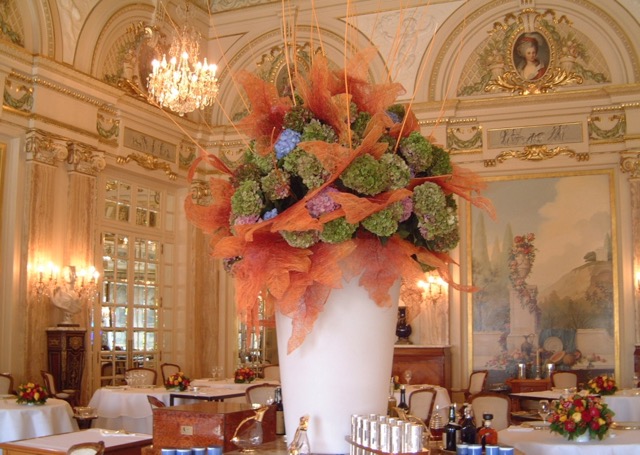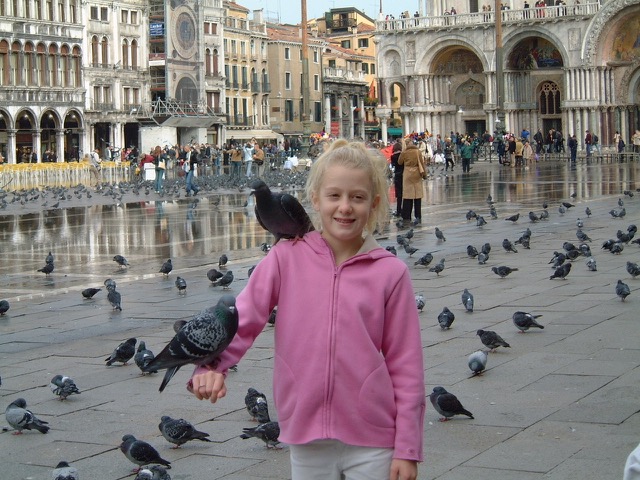BY JANET STEINBERG
For
singers, their song would be “Amazing grace…how sweet the sound”.
singers, their song would be “Amazing grace…how sweet the sound”.
For
travelers, their song would be “Amazing place…how sweet the town”.
travelers, their song would be “Amazing place…how sweet the town”.
Since
I am an inveterate travel, I will sing you my song. So here I go…with my
amazing places…some of the sweetest towns in Europe.
I am an inveterate travel, I will sing you my song. So here I go…with my
amazing places…some of the sweetest towns in Europe.
MONACO,
MONTE CARLO: After Vatican City, this tiny fairy-tale principality bounded
by the French Riviera to the west and the Italian Riviera to the east, is
the second smallest country in the world.
MONTE CARLO: After Vatican City, this tiny fairy-tale principality bounded
by the French Riviera to the west and the Italian Riviera to the east, is
the second smallest country in the world.
Atop “The
Rock” is the Pink Palace, home of His Serene Highness, Prince Albert II, The
Sovereign Prince of Monaco, and the precariously perched Oceanographic Museum
that had been endowed by the Royal family and assisted by the late Jacques
Cousteau.
Rock” is the Pink Palace, home of His Serene Highness, Prince Albert II, The
Sovereign Prince of Monaco, and the precariously perched Oceanographic Museum
that had been endowed by the Royal family and assisted by the late Jacques
Cousteau.
Also
atop “The Rock” in Monaco-Ville (the old city) is the nineteenth century,
neo-Romanesque, white stone Cathedral in which lie the remains of
H.R.H.Princess Grace and her husband Prince Ranier III. This is the
same cathedral in which Prince Ranier married his Hollywood film star Grace
Kelly on April 19, 1956.
atop “The Rock” in Monaco-Ville (the old city) is the nineteenth century,
neo-Romanesque, white stone Cathedral in which lie the remains of
H.R.H.Princess Grace and her husband Prince Ranier III. This is the
same cathedral in which Prince Ranier married his Hollywood film star Grace
Kelly on April 19, 1956.
Descending
from “The Rock” that towers 200-feet above the sea, one is overwhelmed
by the beauty of the fountains and the gardens in front of the ornate
crystal-chandeliered CASINO OF MONTE CARLO and the Belle Epoque Hotel
de Paris.
from “The Rock” that towers 200-feet above the sea, one is overwhelmed
by the beauty of the fountains and the gardens in front of the ornate
crystal-chandeliered CASINO OF MONTE CARLO and the Belle Epoque Hotel
de Paris.
Hotel
de Paris offers a unique dining experience at Le Louis XV. Le Louis
XV, in Monte Carlo’s Hotel de Paris, is like no other restaurant in the
world. This temple of haute cuisine (where
table cloths are ironed on the table prior to its setting, where cutlery is
polished by white-gloved assistants, where silver-filigree Christofle hedge
sparrows peck at imaginary crumbs, and where the monthly flower bill averages
in five figures) definitely belongs at the top of your “Bucket
list”.
de Paris offers a unique dining experience at Le Louis XV. Le Louis
XV, in Monte Carlo’s Hotel de Paris, is like no other restaurant in the
world. This temple of haute cuisine (where
table cloths are ironed on the table prior to its setting, where cutlery is
polished by white-gloved assistants, where silver-filigree Christofle hedge
sparrows peck at imaginary crumbs, and where the monthly flower bill averages
in five figures) definitely belongs at the top of your “Bucket
list”.
LE
LOUIS XV RESTAURANT IN HOTEL DE PARIS
LOUIS XV RESTAURANT IN HOTEL DE PARIS
VENICE,
ITALY: The picture-postcard city of Venice, floating on an equally
photogenic canal, has been dubbed La Serenissima, (The Most
Serene). She has been called the faded beauty in the family of
Italian cities…“her blondness now from a bottle and her perfume slightly
stale”. Napoleon called Venice’s Piazza San Marco (St. Mark’s Square)
the largest drawing room in Europe.
ITALY: The picture-postcard city of Venice, floating on an equally
photogenic canal, has been dubbed La Serenissima, (The Most
Serene). She has been called the faded beauty in the family of
Italian cities…“her blondness now from a bottle and her perfume slightly
stale”. Napoleon called Venice’s Piazza San Marco (St. Mark’s Square)
the largest drawing room in Europe.
No
matter what you call her, Venice is a city in which you will want to get
lost. Finding your way back, amid the maze of streets
and “highways” paved in water, is part of the Venetian experience.
Whether you choose to walk your legs off, hire a private water taxi, ride the
public water bus known as the vaporetto, or glide along in a
private (but pricey) gondola, you will find something amazing in every nook and
cranny of Venice.
matter what you call her, Venice is a city in which you will want to get
lost. Finding your way back, amid the maze of streets
and “highways” paved in water, is part of the Venetian experience.
Whether you choose to walk your legs off, hire a private water taxi, ride the
public water bus known as the vaporetto, or glide along in a
private (but pricey) gondola, you will find something amazing in every nook and
cranny of Venice.
A
short vaporetto ride from the Piazza San Marco to Giudecca
island is jam-packed with views of the Gothic splendor of the Doge’s Palace,
the angel-topped Campanile, the Byzantine domes of St. Mark’s Basilica and the
nearby baroque masterpiece churches of Santa Maria Della Salute, San Giorgio
Maggiore and Il Redentore. The Jewel on Giudecca’s crown is the
fabulous Cipriani Hotel.
short vaporetto ride from the Piazza San Marco to Giudecca
island is jam-packed with views of the Gothic splendor of the Doge’s Palace,
the angel-topped Campanile, the Byzantine domes of St. Mark’s Basilica and the
nearby baroque masterpiece churches of Santa Maria Della Salute, San Giorgio
Maggiore and Il Redentore. The Jewel on Giudecca’s crown is the
fabulous Cipriani Hotel.
 |
|
BATHING
HOTEL CIPRIANI-STYLE |
Of
course, when you cross back over the canal, you must pay a visit to Harry’s
Bar. It has been said that, in the legendary city of Venice, more tourists ask
directions to Harry’s Bar than to the Piazza San Marco.
course, when you cross back over the canal, you must pay a visit to Harry’s
Bar. It has been said that, in the legendary city of Venice, more tourists ask
directions to Harry’s Bar than to the Piazza San Marco.
The
one and only original Harry’s Bar is not your ordinary watering hole. It is a
fashionable haunt frequented by celebrities, royalty, locals, and
tourists. The bar’s liquid trademark is the
Bellini.
one and only original Harry’s Bar is not your ordinary watering hole. It is a
fashionable haunt frequented by celebrities, royalty, locals, and
tourists. The bar’s liquid trademark is the
Bellini.
Veni, Vidi, Vici Venezia. I
came, I saw, I conquered Venice. You should do the same!
came, I saw, I conquered Venice. You should do the same!
BUDAPEST,
HUNGARY: Approaching Budapest (pronounced Budapesht) at night
from the Danube River is a breathtaking sight. The
city, gracing both sides of the Danube, is ablaze with thousands of
lights. Lights outline the regal bridges, the Neoclassical buildings and
the grand monuments. The city is a veritable fairyland, a fantasy that Walt
Disney might have conjured
up.
HUNGARY: Approaching Budapest (pronounced Budapesht) at night
from the Danube River is a breathtaking sight. The
city, gracing both sides of the Danube, is ablaze with thousands of
lights. Lights outline the regal bridges, the Neoclassical buildings and
the grand monuments. The city is a veritable fairyland, a fantasy that Walt
Disney might have conjured
up.
This
exotic, mysterious city that had been devastated in WWII and inaccessibly
cloistered behind an Iron Curtain in the last half
of the 20th century, has been rebuilt and reinvented by its
proud people.
exotic, mysterious city that had been devastated in WWII and inaccessibly
cloistered behind an Iron Curtain in the last half
of the 20th century, has been rebuilt and reinvented by its
proud people.
The city we know as Budapest was once three cities
existing side by side. Obuda, Buda, and Pest. In 1873, under the
reign of the Austro-Hungarian Empire, the three were united to form the city of
Budapest.
existing side by side. Obuda, Buda, and Pest. In 1873, under the
reign of the Austro-Hungarian Empire, the three were united to form the city of
Budapest.
With 3000 seats, The Dohany
Street Great Synagogue, built in Byzantine-Moorishstyle between 1854-1859, is
the largest synagogue in Europe and the second largest in the world.
Street Great Synagogue, built in Byzantine-Moorishstyle between 1854-1859, is
the largest synagogue in Europe and the second largest in the world.
The Weeping Willow sculpture (The Hungarian
Holocaust Victims and Heroes Memorial) unveiled behind the Great Synagogue in
1991 was funded by the late actor Tony Curtis, is in loving memory of his
Hungarian-born parents.
Holocaust Victims and Heroes Memorial) unveiled behind the Great Synagogue in
1991 was funded by the late actor Tony Curtis, is in loving memory of his
Hungarian-born parents.
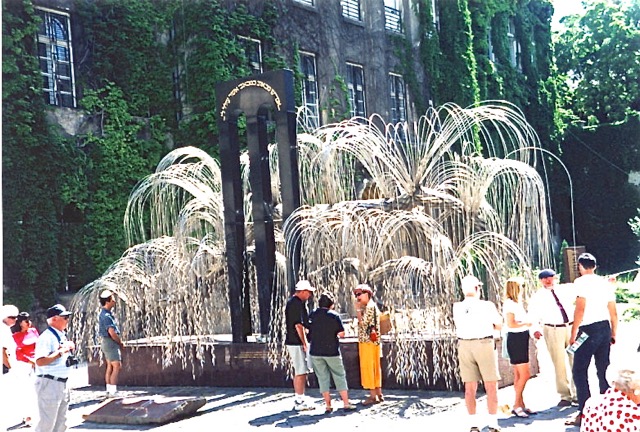 |
| WEEPING WILLOW HOLOCAUST MEMORIAL |
“Taking the waters” at the Gellert Spa is a Pesti (pronounced peshtee) tradition. The
Art Nouveau spa inspired by Rome’s baths of Caracalla, offers therapeutic
massages at bargain basement prices. But don’t expect Baden-Baden luxury.
Art Nouveau spa inspired by Rome’s baths of Caracalla, offers therapeutic
massages at bargain basement prices. But don’t expect Baden-Baden luxury.
 |
|
GELLERT SPA
|
For some down-home Hungarian cooking, head to
Bagolyvár (The Owl’s Castle.) This restaurant, in a
rustic Transylvanian manor house next door to Gundel, is unique in
Hungary. Bagolyvar serves comfort food like mama (or grandma) used
to make. Next door, in an exquisite turn-of-the-century
mansion, is Gundel Restaurant, founded in City Park (Varosliget
) in 1894. At Gundel, refined versions of traditional
Hungarian dishes, as well as the aristocratic cuisine of the Austro-Hungarian
era, are served.
Bagolyvár (The Owl’s Castle.) This restaurant, in a
rustic Transylvanian manor house next door to Gundel, is unique in
Hungary. Bagolyvar serves comfort food like mama (or grandma) used
to make. Next door, in an exquisite turn-of-the-century
mansion, is Gundel Restaurant, founded in City Park (Varosliget
) in 1894. At Gundel, refined versions of traditional
Hungarian dishes, as well as the aristocratic cuisine of the Austro-Hungarian
era, are served.
In my book, the word ‘Gundel’ is synonymous with
the word ‘Budapest.’
the word ‘Budapest.’
BARCELONA,
SPAIN: Barcelona,
posa’t guapa. “Barcelona, make yourself
beautiful.” That was the slogan made up by the city government
prior to the 1992 Summer Olympic Games. The vibrancy and enthusiasm
of the natives resulted in the beautification of the ornate, imaginative
facades of the classic Modernist homes. Years of dirt and pollution
were removed to reveal intricate mosaics, colorful stained-glass windows, and the
sinuous lines and curlicues of the architecture of which Antoni Gaudi’s work is
the best-known example.
SPAIN: Barcelona,
posa’t guapa. “Barcelona, make yourself
beautiful.” That was the slogan made up by the city government
prior to the 1992 Summer Olympic Games. The vibrancy and enthusiasm
of the natives resulted in the beautification of the ornate, imaginative
facades of the classic Modernist homes. Years of dirt and pollution
were removed to reveal intricate mosaics, colorful stained-glass windows, and the
sinuous lines and curlicues of the architecture of which Antoni Gaudi’s work is
the best-known example.
Gaudi’s Sagrada Familia
Cathedral (Church of the Sacred Family), with surreal spires
said to resemble a melting wedding cake, was initiated by Gaudi in 1882 and has
not as yet been completed.
Cathedral (Church of the Sacred Family), with surreal spires
said to resemble a melting wedding cake, was initiated by Gaudi in 1882 and has
not as yet been completed.
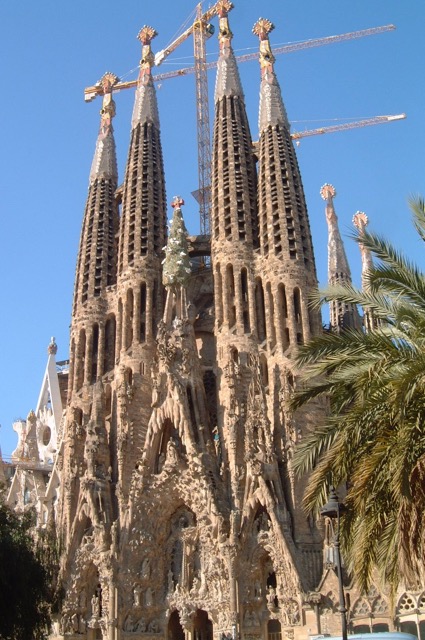 |
|
GAUDI’S |
La Pedrera, one of Gaudi’s later works, exemplifies
the inseparability of art and technique. From the roof terrace of the Pedrera
you can observe the skylights and chimneys as well as a grand
overview of the city. Nearby, the Casa Batllo´ is
another Gaudi example of Modernism, the architectural trend of the late 19th
and early 20th centuries.
the inseparability of art and technique. From the roof terrace of the Pedrera
you can observe the skylights and chimneys as well as a grand
overview of the city. Nearby, the Casa Batllo´ is
another Gaudi example of Modernism, the architectural trend of the late 19th
and early 20th centuries.
Barcelona offers many renowned museums
including Museu Picasso and Fundacio´ Joan Miro´. Yet
Barcelona itself is a veritable museum of art and architecture, much of which
can be seen and appreciated without ever entering a museum. Explore
the twisted medieval streets of the ancient Bari Gothic, the
old town district also known as the Gothic Quarter.
including Museu Picasso and Fundacio´ Joan Miro´. Yet
Barcelona itself is a veritable museum of art and architecture, much of which
can be seen and appreciated without ever entering a museum. Explore
the twisted medieval streets of the ancient Bari Gothic, the
old town district also known as the Gothic Quarter.
Barcelona’s waterfront can be easily found by
heading towards the Monument a Colom (Columbus Monument) that
rises more than 150-foot tall on the square known as Placa del Portal
de la Pau. The soaring monument stands in the port at the foot
of La Rambla, the lively tree-lined esplanade filled with cafes,
shops, vendors, artists and mimes.
heading towards the Monument a Colom (Columbus Monument) that
rises more than 150-foot tall on the square known as Placa del Portal
de la Pau. The soaring monument stands in the port at the foot
of La Rambla, the lively tree-lined esplanade filled with cafes,
shops, vendors, artists and mimes.
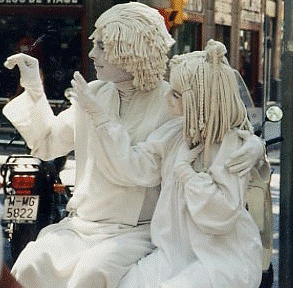 |
| MIMES ON LA RAMBLA |
Barcelona…Ole!
JANET
STEINBERG is an award-winning Travel Writer, and International Travel
Consultant with THE TRAVEL AUTHORITY in Mariemont, Ohio. She is
the winner of 41 national Travel Writing Awards.
STEINBERG is an award-winning Travel Writer, and International Travel
Consultant with THE TRAVEL AUTHORITY in Mariemont, Ohio. She is
the winner of 41 national Travel Writing Awards.


